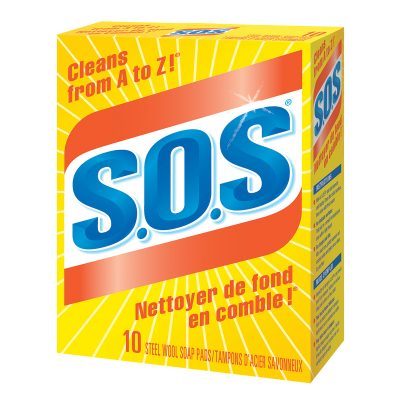– OR –
Ingredients Inside :S.O.S® Steel Wool Soap Pads 67029931012

Product Name and UPC: S.O.S® Steel Wool Soap Pads 67029931012
Product Ingredients
- Steel Wire
- Steel wire or steel wool is used in abrasive pads to remove heavy, baked-on soils in areas such as ovens or cooking pots.
- Sodium Tallowate
- Sodium tallowate is a type of soap added to improve the cleaning ability of laundry detergents and other cleaning products.
- Water
- Water, also sometimes listed on product labels as aqua, is the most widely used of all solvents. It is a colorless, odorless and flavorless liquid and serves as the base of many cleaning products.
- Glycerin
- Glycerin is used in soaps, lotions and creams to add moisturizing qualities. It is a neutral, colorless liquid made during soap production.
- Sodium Carbonate
- Sodium carbonate, also known as washing soda and soda ash, is an alkalinity builder, which is added to laundry detergents to improve cleaning efficiency. It also helps remove alcohol and grease stains from clothing. Builders act like water softeners, to remove calcium, magnesium and other ions found in tap water, that can interfere with the cleaning process.
- Cocamide MEA
- Cocamide MEA (also known as coconut fatty acid amide) is a plant-derived surfactant comprising a 1:1 ratio of coconut fatty acid and monoethanolamine. It is used in household cleaning products and detergents to help remove soils, to stabilize foam, and to thicken the product.
- Sodium Nitrite
- Sodium nitrite is a corrosion inhibitor added to aerosol products to protect the can from rusting, or to detergents to protect metal components of washing machines and automatic dishwashers from rusting.
- Oleic-Stearic Acid
- Neutralized oleic-stearic acid is a soap formed by the reaction of sodium hydroxide and the blend of oleic and stearic fatty acids. It is used primarily for foam control, though at higher levels can provide a creamy feel to a composition.
- Sodium Dodecylbenzenesulfonate
- Sodium dodecylbenzenesulfonates are surfactants or cleaning agents used in liquid and powder laundry detergents and other cleaning products.
- C.I. Pigment Blue 15 (74160)
- C.I. Pigment Blue 15 is a colorant (dye or pigment) added to cleaning products to improve aesthetic appeal, or to act as a tracer (for example in certain toilet bowl cleaners, blue coloration indicates that the product is working). They can be made from both synthetic and natural materials.
- d-Limonene
- d-Limonene is used in cleaning products to help dissolve stains and soils and as a fragrance component. A member of a class of chemicals called terpenes, d-Limonene is obtained from the rinds of citrus fruits. It has been identified as a potential allergen by the Scientific Committee on Consumer Safety, an advisory board to the European Union..
- Dilauryl Thiodipropionate
- Dilauryl thiopropionate is a preservative, a class of ingredients used to help prevent products from deteriorating over time, maximizing their shelf-life and ensuring efficacy and safety. Preservatives work by inhibiting growth of bacteria or mold, or by absorbing oxygen that can oxidize ingredients.
- Fragrance
- Fragrances and perfumes are mixtures of fragrant essential oils, aroma compounds, fixatives and solvents. They are used in cleaning products to add a particular scent (lavender, lemon, etc.) to clothes and homes, and to mask unpleasant odors. Clorox provides a separate list of all the fragrance ingredients used in our household and professional cleaning, disinfecting and laundry products.
- Sodium Hydroxide
- Sodium hydroxide, also known as caustic soda or lye, is used as a pH adjuster in cleaning products. As an alkali, it is useful in cleaning products for removing soils that are fatty, oily or acidic.
- Sodium Metasilicate
- Sodium metasilicate is often used as a corrosion inhibitor when added to detergents to protect metal components of washing machines. It also prevents soils from depositing on fabrics during the wash cycle.
- Titanium Dioxide
- Titanium dioxide is an inorganic pigment, which can be added to plastic resins to make them opaque and to cleaning products to give them a rich, creamy appearance.
Clorox lists all fragrance components identified as potential allergens by the Scientific Committee on Consumer Safety, an advisory board to the European Union, when they are present at a concentration of more than 0.01 percent or greater in the product and provides a separate list of all the fragrance ingredients used in our household and professional cleaning, disinfecting and laundry products.
Product ingredients are listed based on the most current information available; please check back periodically for formulation updates. If you have questions regarding a product or the ingredient listing for a product, please contact us for additional information.
